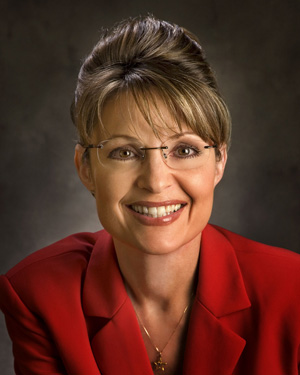
Alaska
Governor
Sarah Palin
12/4/2006 - ? |
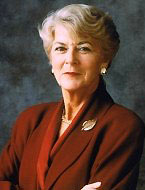
Congresswoman
Geraldine
Ferraro
1/3/79 – 1/3/85 |

Commissioner
Katharine
Bement Davis
1914 & 1915 |
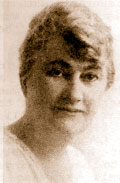
Workhouse
Superintendent
Mary M. Lilly
1919 - 1928 |
©Foursome of Ticket Firsts:
Sarah Palin, Geraldine Ferraro . . . .
Katharine Bement Davis? Mary M. Lilly?
-- Chapter II |
KBD Agrees to Campaign for Suffrage If OK With Mayor
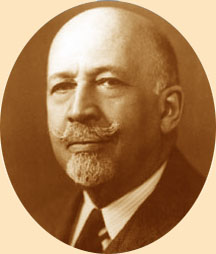 | | The above image is based on a photo of W.E.B. DuBois (historian, educator, civil rights advocate) that appears on a National Park Service web page about his boyhood home. KBD's help in the research project resulting in his landmark report The Philadelphia Negro: A Social Study in described in Chapter 5 of Correction's Katharine Bement Davis:
New York City's Suffragist Commissioner on this web site.
|
KBD explained to Mrs. Catt that career demands during different phases of her life --
- running a settlement house in Philadelphia (where she helped W. E. B. DuBois' sociological research),
- getting her Ph. D in political economy (a first for a woman at the University of Chicago),
- running Bedford Hills Reformatory (for 13 years after opening it).
-- had left her little spare time to devote to the suffragist struggle, though she believed in it.
But if Mayor Mitchel had no objection to her getting involved, Katharine told Catt, she was willing to help in whatever way she could.
For her, it would be returning to the cause.
In the late 1870s and early 1880s, when Davis was a young teacher in Dunkirk, N.Y., she had led a women's literary club, organized a women's political equality group, and even became the first woman in the town to ride a bicycle with a divided skirt.
City Hall Reporters Foresee Change Coming With KBD
Mrs. Catt wasn't the only one to see in the Davis appointment the potential for other changes in NYC gender history. On Feb. 21, 1914, less than two months into KBD's tenure at DOC, the Association of City Hall Reporters, a precursor to today's Inner Circle, tipped its collective hat -- albeit with a collective tongue in cheek -- in the direction of the woman commissioner.
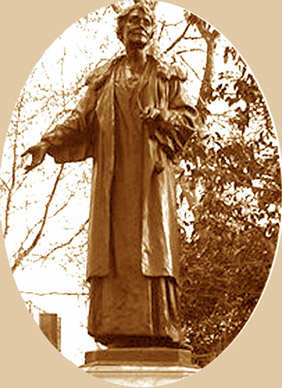 | | A statue of British suffragist Emmeline Pankhurst in Victoria Tower Gardens, Westminster, London. Click the image to access the Wikimedia Commons page featuring related information and the color photo from which the above is derived.
|
As one part of its annual show spoofing the government officials and politicians its members covered, the reporters association officers read "telegrams" from invited dignitaries expressing "regrets" at being unable to attend the event.
One such "wire" supposedly came from a British suffragist leader Mrs. Emmeline Pankhurst and her grown suffragist daughters, Sylvia and Christabel. According to the New York Times story the next day, it read:
Greetings to the Association of City Hall Reporters. But, remember, greetings to you for the last time as feudal lords. No more stag parties. Have all the fun you can tonight, for thereafter women reporters will be present to let the other half know what is going on behind closed doors. Your guests may consider they are tonight enjoying an exclusive privilege of a passing age. Regards to Kate Davis.
Part of the humorous irony attached to last line of the mock telegram from the Pankhursts, sending "Regards to Kate Davis," arose from the strong possibility that, if the Pankhursts had been campaigning for suffrage in New York City at the time, one or more of them or their followers could very well have landed behind bars in one of Kate Davis' jails.
Not infrequently a Pankhurst or Pankhurst follower landed behind British jail bars because of the extremely militant, physically aggressive and property-destructive tactics they used to gain attention for their cause.
Interestingly, both the British suffragist Christabel Pankhurst and Commissioner Davis would attend the same rally in Carnegie Hall later that year (1914) to raise funds for the campaign to win November 1915 passage of a state constitutional amendment enfranchising NY women.
KBD Begins Suffrage Campaign: Pageant, Ball, Rally, Speeches
The Women's Suffrage Organization of the 35th Assembly District holding a reception in honor of Mrs. Mitchel at the Fordham Club March 10, 1914, and Commissioner Davis being listed as a prominent invited guest may have had absolutely nothing to do with gaining and maintaining Mayor Mitchel's acquiescence to Commissioner Davis' suffrage activities. But, as the saying goes, "it couldn't hurt."
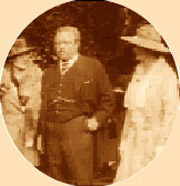 | | Mrs. Norman deR. Whitehouse, left, chairwoman of the New York State Woman Suffrage Party and Mrs. James Lees Laidlaw, right, chat with TR at his Sagamore Hill, L.I., estate Sept. 8, 1917 about the campaign to win approval at the polls Nov. 6 of a state equal suffrage amendment. Click the image to access a Library of Congress American Memory web page with the film strip frame from which the image above is derived.
|
On April 17, 1914, Commissioner Davis and James Lees Laidlaw, president of the Men's League for Woman Suffrage, led a parade within the 71st Regiment Armory to conclude a pageant and to open a ball sponsored by the league to promote the cause. Both Mayor Mitchel and Commissioner Davis were among those heading the list of patrons and patronesses of the pageant and ball.
The high regard in which Commissioner Davis was held by suffragists was almost painfully evident May 2, 1914, at a Suffrage Day standing-room-only Carnegie Hall rally that overflowed into 57th St. where other suffragist speakers addressed the open-air crowd. The meeting culminated an all-day series of suffrage events throughout the city.
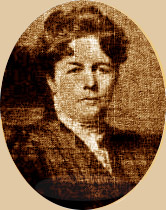 | Harriet Stanton Blatch.
Daughter of Elizabeth Cady Stanton, she was the founder and president of Equality League of Self Supporting Women whose offices occupied a floor in the Women's Trade Union League building in NYC. The image above is derived from one in Project Gutenberg's What eight million women want by Rheta Childe Dorr. Click the image above to access it.
|
Mayor Mitchel's speech of welcome came across poorly, to say the very least. He so stressed the importance of women performing public service, even in the absence of having the vote, that he seemed to be downplaying the importance of their gaining the vote. His brief talk was received in stony silence, with one notable exception.
The New York Times the next day reported:
". . . what [Mitchel] said in a five-minute speech moved [the meeting "chairman"] Mrs. [Stanton] Blatch to say later, that with the exception of his wonderful tribute to Commissioner Davis, he had expressed not one modern thought, and his speech sounded as though it had been written 100 years ago. Then she called on Miss Josephine Casey, a labor leader, to reply to the Mayor . . . .
. . . To Commissioner Davis the audience gave the compliment of rising as she was introduced . . . ."
TR & KBD Confer on
Constitutional Delegate candidacies
A key meeting in the series of events leading to Commissioner Katharine Bement Davis' historic candidacy seems to have been a conference July 15, 1914, between Teddy Roosevelt and the Progressive Party's top women in New York State. The New York Times the next day reported that for the first time in NY, a major political party's leader conferred with women of his party. He was the special guest of two dozen women workers at a conference luncheon in the Colony Club.
 | | The above graphic pen sketch of TR addressing a suffragist audience from his Sagamore Hill, L.I., porch is a composite inspired by a number of different website photos of the same 1917 event.
|
Col. Roosevelt sat at the right of the presiding officer Miss Anne Rhodes . . . . At Col. Roosevelt's right sat the Commissioner of Correction, Katharine Bement Davis . . . .
No definite action was taken at the meeting, and after speeches by Col. Roosevelt and Dr. Davis, the discussion was conducted in informal conversation . . . .
Representatives of the press were not admitted. Col. Roosevelt's speech was given out after it had been carefully edited and approved by him. Dr. Davis' speech also was handed out after its author had made it suitable for publication.
Miss Rhodes was quoted to the effect that mentioned in the discussions were the woman suffrage question and women participating in the Constitutional Convention. She said the names of several women had been suggested as possible delegate candidates.
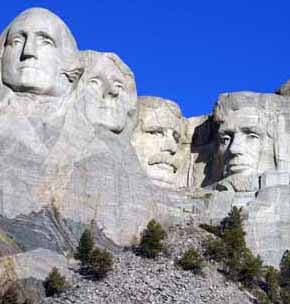 | | Mount Rushmore National Monument -- featuring the faces of Washington, Jefferson, Teddy Roosevelt and Lincoln -- is one of the world's largest sculptures and a national park. To access National Park Service web page featuring it, click image.
|
Col. Roosevelt had much to say to Dr. Davis, his neighbor during the luncheon, and was one of the most enthusiastic in applauding when she spoke. . . .
The "colonel" was quoted as saying he favored the Progressive Party nominating a "certain proportion of women" for the Constitution Convention.
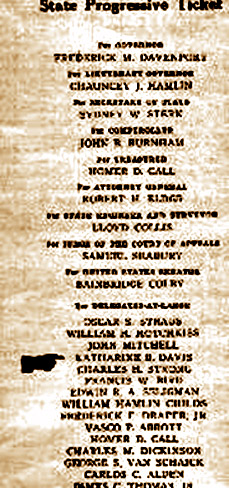 | | The 1914 Progressive Party ticket lineup is shown here as it appeared a campaign piece promoting KBD's candidacy, complete with a pointing hand. The campaign bio declared: "Katharine Bement Davis --- Nominated by the Progressive Party at the request of the Women's Temporary Committee of the State of New York for Representation in the Constitutional Convention." See Chapter 1 of Correction's Katharine Bement Davis: New York City's Suffragist Commissioner on this web site.
|
The Times story continued:
Miss Davis said she was a Progressive because she had always occupied middle ground. She said she was not radical enough for her radical friends or conservative enough for the conservative ones. . .
"We must take men and women from both parties to make a party that will represent the middle ground . . . . "
KBD on TR Party State Ticket
On Aug. 27, 1914, in Utica, N.Y., the Progressive Party state convention, before selecting its nominees for governor, U.S. Senator, etc. designated its candidates for constitutional delegates-at-large (this is, statewide delegates as distinguished from local district delegates).
The New York Times the next day reported:
When the name of Dr. Katharine B. Davis, New York City's Commissioner of Correction, was read from the list there was a strong outburst of applause led by the several women who are members of the State Committee.
The name of James C. Thomas Jr., who if elected will be the first Negro delegate at large to sit in a Constitutional Convention in this State was also greeted with approval.
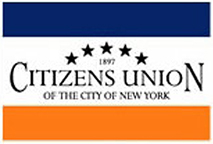 | | Since 1910 the Citizens Union has published Voter Directories that have helped inform and guide NYC electorates on the candidates seeking elected office. CU has been a major force for civic betterment, good government and fair elections for more than a century. Click image above to access CU's history timeline.
|
The Times on Oct. 25, 1914. using materials gathered by the Citizen Union and the New York City Committee for the Constitution Convention published a candidates directory providing thumbnail sketches of 224 convention delegate candidates. The preamble to the directory explained:
There are to be elected 15 Delegates at Large [statewide] and three delegates from each senatorial district. In the three principal parties, Democratic, Republican and Progressive, there are 45 candidates for Delegates at Large and 179 for District Delegates from New York City.
The thumbnail sketch on KBD read:
Miss Katharine B. Davis, New York City -- Sociologist; formerly Supt. Bedford Reformatory, where she gained nationwide recognition as an authority on reformatory methods; Commissioner of Correction New York City '14 under Mitchel Administration.
The thumbnail sketch on Thomas Jr. read:
James C. Thomas Jr., New York City -- Lawyer, active in Afro-American educational and social work.
Mayor Mitchel Not Only OKs, But Endorses KBD Candidacy
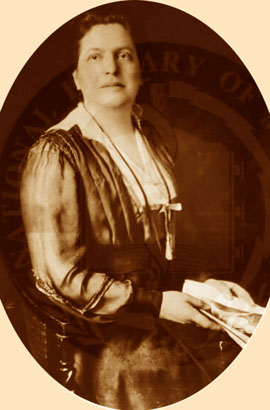 | Lillian Wald.
Founder of the Henry Street Settlement house, she developed pioneering programs that became the Visiting Nurse Service of New York (VNSNY) and is generally regarded as the founder of public health nursing in the U.S. Wald chaired the Women's Temporary Committee of the State of New York for Representation in the Constitutional Convention. The above image is a version of one found on several professional nursing websites. Click to access the VNSNY history web page.
|
On Oct. 28, 1914, the Women's Temporary Committee of the State of New York for Representation in the Constitutional Convention issued a press release that included the text of a letter from NYC Mayor John Purroy Mitchel to Miss Lillian D. Wald, the committee "chairman:"
Dear Miss Wald:
I have been asked whether or not I approve of the candidacy of Dr. Katharine B. Davis, Commissioner of Correction, as delegate at large to the State Constitutional Convention. I heartily approve and endorse her candidacy.
. . . . Miss Davis, through her long experience in social and educational work, is peculiarly well qualified to assist in the solution of these important problems. . . . .
Very truly yours,
JOHN PURROY MITCHEL,
Mayor
Support for KBD Candidacy Crosses Party Lines
At an Oct. 29, 1914, Progressive Party rally in Cooper Union for its entire statewide slate of candidates KBD was introduced by TR himself.
On Oct. 30, 1914, the anti-Tammany Hall Citizen Union announced its picks among the 45 Constitutional Convention Delegates-at-Large candidates. The Times the next day reported:
The Citizen Union has picked what it calls a model ticket of Delegates-at-Large to the Constitutional Convention from among the 45 Democratic, Republican and Progressive candidates,
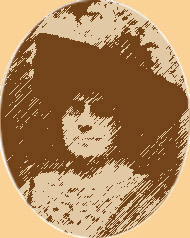 | | Click above graphic pen sketch to access the Library of Congress image of Woman’s National Democratic League leader Mrs. Stephen B. Ayres that inspired it. Wife of a Bronx Democratic Congressman, Mrs. Ayres was one of the speakers at the Oct. 31, 1914 Political Education League rally for KBD's election as constitutional convention delegate-at-large.
|
and in a statement issued yesterday it calls attention of the voters throughout the state to the qualifications of the candidates it has selected, and urges the importance of their election. . . .
The statement adds that too much stress cannot be placed upon the importance which attaches to the election of delegates-at-large, as they will take an especially prominent part in the deliberations and exercise an influence over the action of the convention out of all proportion to their number.
The Citizen Union listed Dr. Katharine B. Davis among the 15 Democratic, Republican and Progressive candidates on its "model ticket."
She was one of five Progressives picked by CU that divided the rest of its ticket with a line-up of seven Republicans and three Democrats.
On Saturday morning, Oct. 31, 1914, leading female members of New York's three major parties addressed a rally for KBD. The Times headline for its next day report on the gathering read:
WOMEN HOLD RALLY
TO BOOM DR. DAVIS
Politician Education League
Supports Her for
Constitutional Convention
Speakers Direct Voters
Miss Boswell Explains to the Men
Present How They Can Scratch
a Ticket Safely
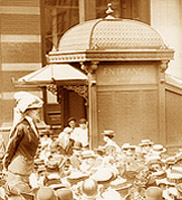 | | Click the above to access the full Library of Congress photo of Progressive Party leader, suffragist and labor activist Miss Alice Carpenter taken circa 1910-1915. It shows her addressing a subway rush hour crowd near Elm and Worth Streets in Lower Manhattan. At one point during the suffrage struggle a private subway line refused to carry pro-women's vote ads. Suffragists then began giving speeches at subway entrances. This image may be one such speech. Miss Carpenter was one of the speakers at the Oct. 31, 1914 Political Education League rally for KBD's election as constitutional convention delegate-at-large.
|
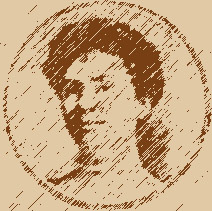 | | Click above graphic pen sketch to access the Jo Freeman Rise of Political Woman in the Election of 1912 web page image of Helen Varick Boswell of the Women's National Republican Association that inspired it. She was one of the speakers at the Oct. 31, 1914 Political Education League rally for KBD's election as constitutional convention delegate-at-large.
|
The opening paragraphs of the story read, in part:
Representatives of three political parties came together yesterday morning at a meeting of the League for Political Education in the Hudson Theatre, held to advance the candidacy of Commissioner of Correction Dr. Katharine B. Davis who seeks election on the Progressive ticket for the Constitutional Convention.
Mrs. S. B. Ayres, representing the Democratic Party; Mrs. Helen Varick Boswell, the Republican, and Miss Alice Carpenter, the Progressives, all supported Dr. Davis . . . .
As a follow-up to the thumbnail sketches of the constitutional convention delegate candidates that it published Sunday, Oct. 25, the Times on Nov. 3, printed side-by-side in three columns -- Democratic, Republican, and Progressive -- the names of the delegate-at-large "nominees of the three principal parties."
KBD Finishes Ahead of 10 Men on Ticket
Evidencing the slower pace of election results in the early 20th Century, the Times was not able to publish even the unofficial tallies of the constitutional convention delegate-at-large contest until Dec. 6, 1914.
Of course, Davis did not win and hadn't expected to win. Winning wasn't the point; just running was. The aim was to call attention to the fact she could run but not vote; no woman in New York could.
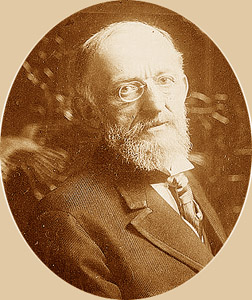 | | Click the above to access the full Library of Congress photo of the Progressive Party's top vote getter among its constitutional convention delegate-at-large candidates, Oscar S. Straus, former Secretary of Commerce and Labor under President Theodore Roosevelt from 1906 to 1909. Straus was the first person of Jewish background to serve in a Presidential Cabinet.
|
Her 87,273 votes statewide placed her 5th among the 15 delegate-at-large candidates running on the Progressive Party ticket.She came in ahead of 10 of the 14 male delegate-at-large candidates on the slate. The entire delegate-at-large section of the Progressive ticket ran better than its top nominee, gubernatorial candidate Frederick Davenport. He received only 45,686 votes whereas highest vote-getter among the party's delegate-at-large candidates, Oscar S. Straus, garnered 123,956.
 | "Colonel" Ida Craft.
Library of Congress photo shows the Prohibition Party's top vote getter among its constitutional convention delegate-at-large candidates, Ida Craft, wearing a bag labeled "Votes for Women pilgrim leaflets" and carrying a banner for a Woman Suffrage Party meeting at the Brooklyn Academy of Music. She helped lead a very small suffragist "army of the Hudson" that hiked from NY to D.C. in the 1912-1913 winter to spotlight their cause. Click image to access full photo.
|
The fact that the numbers for the Progressives' top vote-getters ran into six digits continued that party's status as one of the three major parties in New York, at least for a short while longer.
The top delegate vote-getters among the two minor parties -- the Socialists and the Prohibitionists -- fielding full delegate-at-large slates received significantly fewer votes than the lowest vote-getter among the Progressive delegate-at-large candidates, Vasco P. Abbott, who drew 66,753 votes.
The top Socialist delegate-at-large candidate, Charles Edward Russell, received only 55,500 votes. That minor party had one female delegate-at-large candidate, Bertha M. Mailly, who received 52,885 votes.
The top Prohibition Party delegate-at-large candidate, Ida Craft, received only 25,607. Interestingly, Davis' vote tally exceeded by about 10,000 the combined vote totals of the three female delegate-at-large candidates on that minor party's ticket (Craft, Louise Lockwood, Frances H. Graham).
Each Republican delegate-at-large candidates' individual vote totals exceeded 600,000 and each of their Democratic rivals' individual totals came in under 600,000 but more than 500,000.
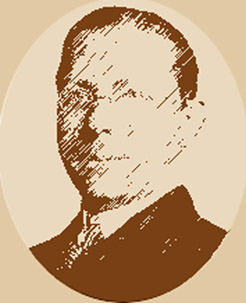 | | Gov. Martin H. Glynn (above), elected lieutenant governor on the Democratic ticket with William Sulzer, succeeded to the governorship upon Sulzer's impeachment in 1913. The graphic pen sketch was inspired by an image on the Kulkul's World website of Nguyen Hoang Viet. Click sketch to access that web page.
|
 | | Charles S. Whitman, former municipal judge, gained fame as Manhattan DA prosecuting NYPD Lt. Charles Becker for murder. The governor's wife was active for woman's suffrage.
Whitman's grandson, John R. married Christine Todd, who became GOP Governor of N.J. and U.S. EPA Administrator. Click image to access the Lt. Becker case on this site.
|
Clearly both those parties had stronger gubernatorial candidates -- Manhattan DA Charles S. Whitman, Republican, who won, and incumbent Democratic Gov. Martin J. Glynn -- and stronger organizations getting out their voters than the Progressives and their top-of-the-ticket candidate Frederick Davenport. He was a former state senator who had run unsuccessfully for lieutenant governor on that party's ticket in 1912.
Almost up to the proverbial 11th hour, several key NY Progressive Party leaders had hoped Col. Roosevelt could be persuaded to again head their ticket. The outcome might have been far different if he had, not only in the gubernatorial race but also for the party's delegates-at-large candidates.
The decline of the Bull-Moose party in that and subsequent elections illustrated the difficulty of building a political party so closely identified with one person, even if that person be someone so larger than life as was TR.
A Sister Reformatory Superintendent a District Delegate Candidate
In a lengthy interview published by the New York Times Oct. 25, 1914, NYC Correction Commissioner Katharine Bement Davis explained how the suffragists organized to get onto various party ballots:
"When it
was thought desirable for women to
have a share in the making of the new
Constitution, we first found out that
there was no legal bar, and then a committee of about 2OO was formed who
met in New York to discuss the best
way of obtaining representation.
"It
was decided to choose the names of
about a dozen women and to ask the
State Committees of the various political
parties to endorse as many of these
women for delegates to the Constitutional
Convention as they were willing
to put upon their tickets."
 | | Mrs. Caroline H. Bliss of Buffalo, whom NYC Correction Commissioner Katharine Bement Davis noted had been among the dozen women whose names were submitted to various political parties for placement on their tickets as constitutional convention delegate candidates, was for many years a member of the board of managers of the Western House of Refuge for Women in Albion, Orleans County, N.Y. Mrs. Bliss became the Progressive Party's delegate candidate in a Buffalo region State Senate district.
Above is a sepia facsimile based on a grayscale NYS Archives photo that provides a 1900 view of a woman being sentenced to the Western House of Refuge for Women also known as the Albion women's reformatory.
Below is a sepia facsimile based on a grayscale NYS Archives photo that provides a 1915 view of infants of inmates at Albion.
Possibly Mrs. Bliss and Commissioner Davis knew each from the latter's more than a dozen years running the Bedford Hills women's reformatory. They would have met at various conferences and conventions involving operation and reform of incarceration institutions for women.
Click either image to access more about the women's reformatory at Albion.

|
She was quoted as noting that, among the dozen or so chosen, were Lillian D. Wald, Frances Kellor, Mrs. Bella L. Israels of Westchester,
and Mrs. Caroline H. Bliss of Buffalo.
Davis said the committee of 200
was non-partisan and included among its
members Mrs. Charles
S. Whitman, wife of the Republican
candidate for Governor: Mrs. J. Borden
Harriman, who was Chairman of the
Women’s Committee in the Wilson campaign;
Grace C. Strachan, active for women teachers getting equal
pay; Mrs.
Gifford Pinchot, wife of a Democratic Congressman; and Florence
Guernsey, Women’s Clubs of New York Federation president.
Along with Davis as its candidate for
delegate at large, the Progressive Party had nominated as district delegate candidates Frances Kellor in
the 17th District, Mrs. C. H.
Bliss in Buffalo, Mrs. Bella L. Israels in
Westchester County, and Gertrude Tone
in Niagara Falls.
Frances W. Graham
of Lockport and Ida Craft of Brooklyn
were seeking election as delegates on the
Prohibition ticket, and Bertha M. Mai1ly
was a candidate on the Socialist ticket.
Miss Davis was quoted as saying she was interested in
all of their candidacies, adding she was sure
that if elected their work would be non-
partisan.
In this respect she thought
they would be different from men,
according to the Times.
Thomas C. McCarthy,
Webmaster
|
